Is Carlos Vargas Seattle Ready?
A dive into whether Carlos Vargas is Major League Ready.
Opening
In 2023, the Mariners made a trade that sent Eugenio Suárez to the D'Backs in exchange for Seby Zavala and Carlos Vargas. Vargas was the main get for the Mariners in this trade, who flashes elite velocity and at one point was ranked as high as the 13th-best prospect in the Cleveland Guardians organization. Throughout his pro career Vargas’s Achilles heel has been his inability to command, which has gotten him into trouble. This is evident in his 2023 stint with the D-Backs, where he posted a 5.79 ERA, 9.04 FIP, 4.53 xFIP, 31.8 K%, and an 18.2 BB% in an extremely small sample of 4 and ⅓ innings. Since that sample is so small, his Triple A results with the Reno Aces are a more accurate representation of who he was prior to the trade, where he posted a 7.02 ERA, 5.51 FIP, 5.61 xFIP, 17.0 K%, and an absurd 15.1 BB% on 42 and ⅓ innings.
A main priority for the Mariners when acquiring Vargas was to get him in the zone more frequently, and that they did. In 2024, Vargas spent the entirety of the season in Triple A for the Tacoma Rainiers and was mightily improved. In 53 and a ⅓ innings, Vargas was able to produce a 3.54 ERA, 4.98 FIP, 4.85 xFIP, 17.1 K%, and a 7.7 BB%. I repeat a 7.7 BB%! In just one year of development, the Mariners were able to turn one of the wildest arms in the minor leagues into a league-average BB%. As a result, it led to an improvement of results.
Due to Vargas playing in Triple A, I have no footage of him actually pitching. Meaning I have no physical tape to assess whether the Mariners made any mechanical changes or not. What I can access, though, from data, is how the Mariners had Vargas decrease his velocity on all his pitches as well as increase his arm angle slightly. I'll get into this in more detail later in the article, but these are the major changes that have led to the mixed improvements for Vargas in 2024.
Changes Seattle Made
Vargas has some of the hardest velocity in all of the big leagues, but what good does it do when it can't be located? When acquiring Vargas, this was the biggest question the Mariners had to answer. To address it, they simply had Vargas throw with less intensity, leading to a decrease in velocity on all of his pitches. We see this with his FB going from 98.3 to 95.3, sinker from 98.0 to 97.1, cutter from 95.9 to 93.0, and his slider from 90.7 MPH to 88.8 MPH.
To go along with this, the Mariners made a slight increase in Vargas’s arm angle. Like I mentioned earlier, I don't have Vargas’s arm angle data, but I can infer there was a change based on his release height and extension. In 2023, Vargas had a release height of 5.6’, which was in part due to his 6.7’ of extension and 39-degree arm angle. In 2024, though, Vargas’s release height increased to 5.9’ with the same amount of extension with 6.7’. Allowing me to come to the conclusion that there was a slight increase in his arm angle.
Results of Adjustments
The combination of these two has allowed Vargas to pound the zone consistently, leading to a 54.3 Zone% in 2024, which was a major step up from his 46.8 Zone% in 2023. Of course this is a drastic improvement from a perspective of keeping walks down, but did this make him more effective? A main problem that I see from Vargas with these changes is his inability to promote chase and miss bats, posting a 25.2 O-Sw% and an 87.0 Z-Con%. Consequently, leading to his second lowest K% of 17.1% and career low in K/9 with a 6.75. This inability to promote chase and miss bats led to hitters absolutely teeing off on his slower velocity, giving up the highest HR/9 of his career at 1.01 and the second highest AVG of .272.
What's strange, though, is even with the higher BB% in 2023, he had eerily similar results, posting a 24.9 O-Sw%, 88.7 Z-Con%, 17.0 K% (lowest of career), and 7.65 K/9 (second lowest of career). While also letting up a career worst .318 AVG and 0.64 HR/9, the second highest of his career (excluding small sample sizes). These alarming similarities make me believe Vargas’s main problem isn't his BB%, but Vargas’s inability to effectively be in the zone without being over the heart of the plate.
As you can see in the heat maps below, there is a major problem with Vargas’s pitch locations. When Vargas is within the zone, he's consistently over the heart of the plate. Leading to the understanding that with or without the velocity changes, Vargas's swing and miss struggles would’ve continued due to his pitch locations.
The decrease in velocity allowed Vargas to be in the zone more consistently, as evidenced by the decreased BB% and increased Zone%, but from a swing and miss standpoint, it didn’t help. I think it's evident why he struggles. Vargas is still missing over the heart of the plate with almost all of his pitches. A positive is, the damage that is being done is with little to no base runners, due to the decreased walks, allowing for his ERA to drastically come down, but it's still a concern how hittable Vargas is.
What to do from Here
So what do the Mariners do from here? The first task on hand must be to get Vargas off the heart of the plate. A start could be as simple as a catcher positioning change like up on 4 seams, sinkers in to righties, cutters in on lefties, and low and away to righties and down and in to lefties with his slider. There needs to be some change to get him to the edges of the zone where he can't be hit around so easily.
To go along with this, I believe the Mariners should really try and implement separation on his pitches. As you can see in the image below, his fastball, cutter, and slider shapes tend to overlap one another, which is another reason why his pitches tend to end up in the same location as well as why his swing and miss and chase results are so low. All of these pitches have very similar movement profiles and do not pose a threat to hitters because they don't have the ability to differentiate from one another.
What I could see them doing is keeping the slider shape around -0.3 iVB and -3.3 iHB because of its exceptional results of .154 AVG, .203 wOBA, .202 xwOBA, and 27.1 Whiff%. To add onto this, I think the Mariners should revert him back to his 2023 cutter shape of 6.5 iVB and -1.0 iHB with more ride and less cut to allow for more separation between his slider than his 2024 version offered. To add a cherry on top, this pitch was extremely productive as well, posting a .143 AVG, .126 wOBA, .292 xwOBA, and 35.7 Whiff%. And lastly, either completely eliminating his 4-seam FB or attempt to get him back to his 2023 shape, where he was able to effectively get behind it, creating separation from his cutter and sinker.
Conclusion
All in all, I think Vargas can still be a productive arm in the major leagues. He has flashes of brilliance stemming from his ability to produce exceptional velocity, but due to bad command and undesirable locations in the zone, he struggles. A main implementation that Vargas needs to make is to get away from the heart of the zone. These changes could be a catcher positioning change, a different cue, or a separation between his pitches; he just needs to make a change. Without this, I don’t see his ability to generate swing and miss to improve. Sadly, causing him to continue to struggle at the minor league level, let alone in the majors. So at the current moment, based on last year's results, I don't think Vargas is Seattle-ready, but I do still believe he has what it takes to be great.


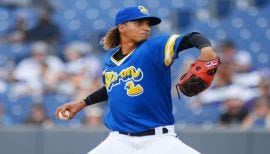


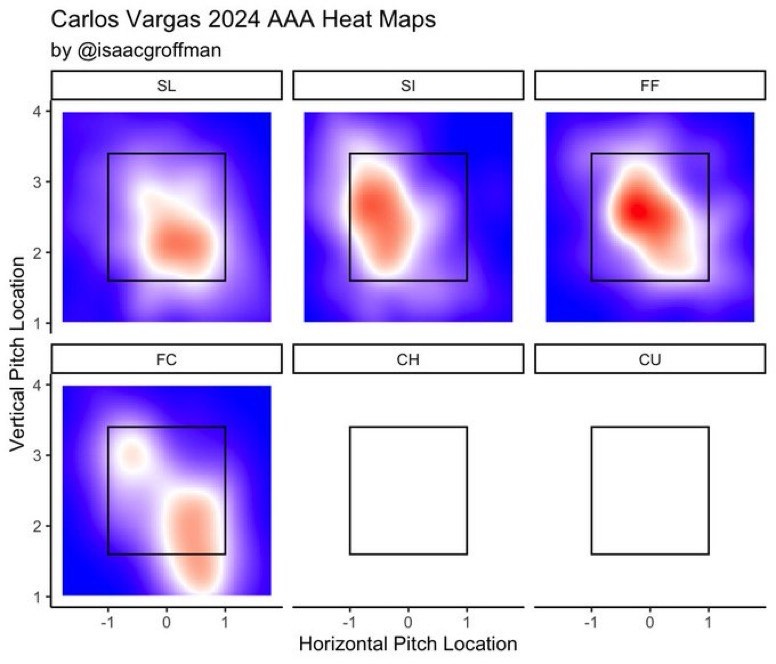
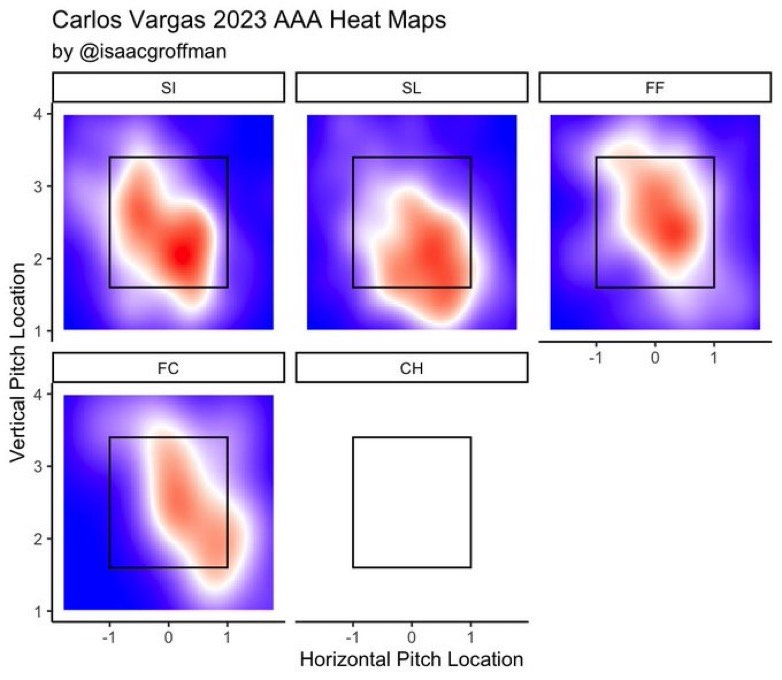
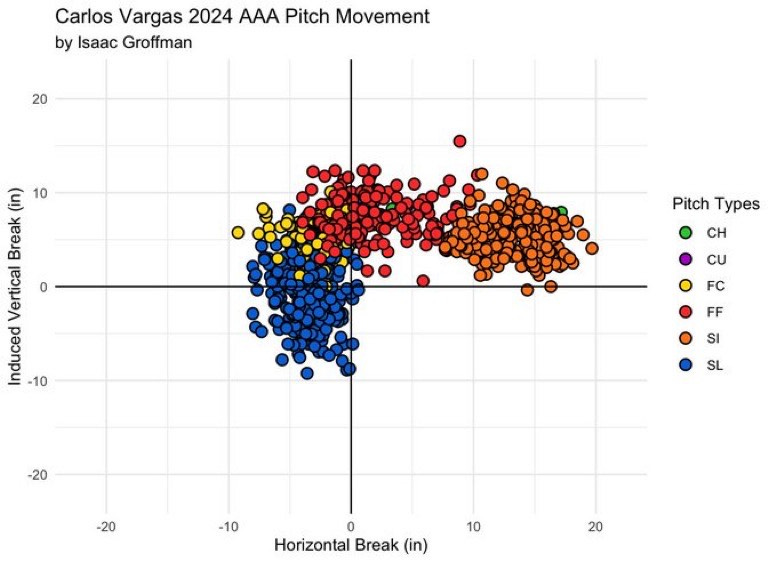
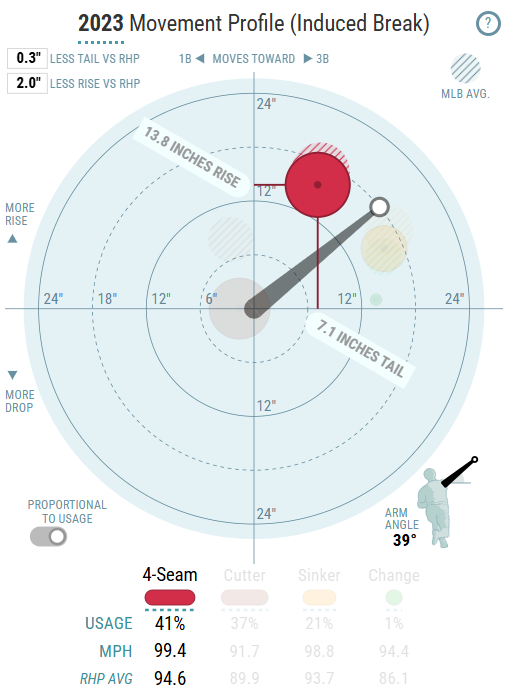
As always, great work Sam!